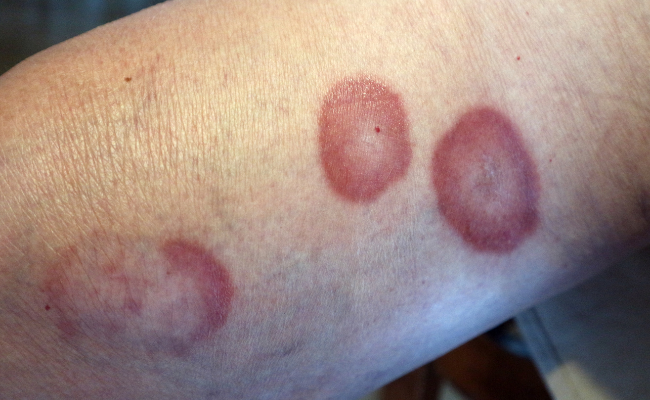How to Treat Granuloma Annulare?
- February 12, 2024
- No Comments

What is Granuloma Annulare?
Granuloma annulare presents as raised, ring-like bumps on the skin, commonly found on the hands, feet, and wrists. Its cause is unclear, though it's believed to involve immune system abnormalities. Though typically harmless, it can persist and occasionally cause mild itching.
Why is it Important to Treat Granuloma Annulare?
While granuloma annulare is not typically associated with serious health complications, treatment may be sought for several reasons:
- Cosmetic Concerns: The appearance of granuloma annulare lesions, particularly when they occur on visible areas of the skin, can cause embarrassment or self-consciousness for some individuals. Treatment aims to improve the cosmetic appearance of the skin by reducing the size and visibility of the lesions.
- Symptom Relief: Although granuloma annulare lesions are usually painless, they may occasionally be accompanied by itching or irritation, particularly if they become inflamed. Treatment can help alleviate these symptoms, improving the overall comfort and quality of life for affected individuals.
- Prevention of Complications: While granuloma annulare itself is not harmful, scratching or picking at the lesions can increase the risk of secondary infections or scarring. Treating the lesions promptly can help prevent these complications and promote faster healing.
- Psychological Impact: Chronic skin conditions like granuloma annulare can have a significant psychological impact, leading to feelings of anxiety, depression, or social isolation. By addressing the condition through treatment, individuals may experience improved emotional well-being and self-esteem.
How to Treat Granuloma Annulare?
Treatment for granuloma annulare varies depending on severity and individual preferences. Options include:
- Topical Corticosteroids: Creams or ointments to reduce inflammation and itching.
- Intralesional Corticosteroid Injections: Direct injections for stubborn lesions.
- Cryotherapy: Freezing lesions with liquid nitrogen for smaller bumps.
- Phototherapy: UV light to reduce inflammation, particularly for extensive lesions.
- Topical Immunomodulators: Medications like tacrolimus to modulate the immune response.
- Oral Medications: For severe cases, corticosteroids or retinoids may be prescribed.
- Surgical Excision: Rarely used for large or persistent lesions.
Treatment Solutions for Granuloma Annulare:
Effective management of granuloma annulare requires a multidimensional approach tailored to the individual patient's needs and preferences. Key considerations include:
- Individualized Treatment Plans: Treatment plans for granuloma annulare should be individualized based on the severity and extent of the lesions, the patient's medical history, and their treatment preferences. A dermatologist or healthcare provider with expertise in skin conditions can help guide treatment decisions and monitor the patient's progress over time.
- Regular Follow-Up: Regular follow-up appointments with a dermatologist or healthcare provider are essential to monitor the progress of treatment and make any necessary adjustments. Patients should be encouraged to report any changes in their symptoms or the appearance of their lesions promptly.
- Patient Education: Educating patients about the nature of granuloma annulare, treatment options, and expected outcomes is crucial for empowering individuals to participate in their care effectively. Patients should be informed about the potential benefits and risks of each treatment modality and encouraged to ask questions and express any concerns they may have.
- Combination Therapy: In some cases, combining different treatment modalities, such as topical and oral medications or phototherapy with topical treatments, may yield better results than using a single approach alone. Combination therapy can target multiple aspects of the condition simultaneously, leading to improved symptom control and faster resolution of lesions.
- Emotional Support: Chronic skin conditions like granuloma annulare can have a significant impact on an individual's emotional well-being, leading to feelings of anxiety, depression, or social isolation. Healthcare providers should be mindful of the psychosocial aspects of the condition and offer emotional support and counseling as needed to help patients cope with the challenges they may face.
Benefits of Treating Granuloma Annulare:
Effective treatment of granuloma annulare offers several potential benefits for affected individuals:
- Improved Symptom Control: Treatment can help alleviate itching, discomfort, and other bothersome symptoms associated with granuloma annulare, improving the overall comfort and quality of life for affected individuals.
- Enhanced Cosmesis: By reducing the size and visibility of lesions, treatment can improve the cosmetic appearance of the skin, leading to increased confidence and self-esteem for individuals with granuloma annulare.
- Prevention of Complications: Prompt and effective treatment can help prevent complications such as secondary infections or scarring, which may occur if the lesions are left untreated or if there is persistent scratching or picking at the skin.
- Faster Resolution: Certain treatment modalities, such as corticosteroid injections or cryotherapy, can lead to faster resolution of lesions, allowing individuals to return to their daily activities more quickly.
- Long-Term Management: Implementing appropriate treatment strategies can help manage granuloma annulare over the long term, reducing the frequency and severity of flare-ups and minimizing the need for aggressive interventions.
Comments (0)